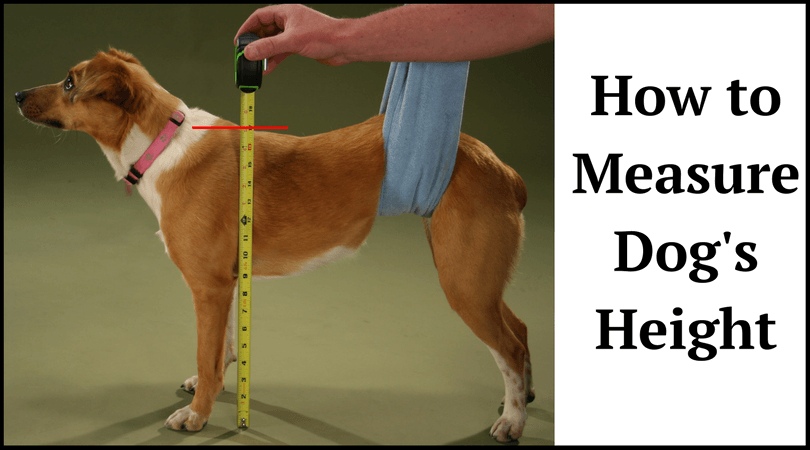Comprehensive Guide: How to Measure Dog Height for Optimal Care and Comfort

Introduction:
Understanding how to measure your dog’s height is an essential aspect of responsible pet ownership. Whether you’re selecting the right size of a crate, determining the appropriateness of a dog door, or tracking your pup’s growth, accurate measurements play a crucial role in ensuring your dog’s well-being and comfort. This comprehensive guide provides step-by-step instructions on how to measure your dog’s height, offering practical tips for various situations and emphasizing the importance of precision in dog care.
Chapter 1: The Significance of Accurate Dog Height Measurements
Accurate dog height measurements are fundamental for numerous reasons, including selecting appropriately sized accessories, monitoring your dog’s growth, and ensuring their safety and comfort. From choosing the right-sized collar to providing a comfortable bed or crate, understanding your dog’s height is essential for meeting their specific needs at various stages of life.
Chapter 2: Tools Needed for Measuring Dog Height
Before delving into the actual process of measuring your dog’s height, it’s crucial to gather the necessary tools. A reliable measuring tape, ideally one designed for sewing or a retractable tape measure, is a primary requirement. For larger breeds, having a second person to assist in holding the dog still during the measurement process can be helpful. Treats and positive reinforcement are also recommended to keep your dog calm and cooperative.
Chapter 3: Measuring Dog Height for Small and Medium Breeds
For small and medium-sized dogs, measuring their height can be a straightforward process. Begin by placing your dog on a flat, non-slip surface. With the dog standing naturally, use the measuring tape to determine the distance from the ground to the highest point of the shoulders, typically referred to as the withers. Ensure the tape is straight and level to obtain an accurate measurement.
Chapter 4: Measuring Dog Height for Large and Giant Breeds
Measuring the height of larger breeds, such as Great Danes or Mastiffs, may require additional assistance due to their size. Have another person hold the dog still, preferably in a standing position. Use the measuring tape to determine the height from the ground to the withers. Maintaining a calm environment and rewarding your dog with treats for cooperation can make the process smoother.
Chapter 5: Measuring Puppies for Growth Tracking
Monitoring your puppy’s growth is essential for ensuring they develop at a healthy rate. Begin by placing the puppy on a level surface. Measure from the ground to the withers and record the result. Repeat this process regularly, ideally every few weeks, to track changes in height. Consistent growth patterns can be indicative of overall health, and any significant deviations may warrant a visit to the veterinarian.
Chapter 6: Tips for Accurate Dog Height Measurements
Achieving accurate measurements requires attention to detail and a cooperative dog. To enhance precision, consider the following tips:
- Measure your dog when they are calm and relaxed to reduce the likelihood of fidgeting.
- Use treats and positive reinforcement to create a positive association with the measuring process.
- Ensure the measuring tape is straight and parallel to the ground for precise results.
- Record measurements in a designated notebook or on a growth chart for future reference.
Chapter 7: Understanding Dog Height Variations
It’s important to note that the height of individual dogs within a breed can vary. Factors such as genetics, nutrition, and overall health contribute to these variations. While breed standards provide general guidelines for height, individual dogs may fall outside these parameters. Paying attention to your specific dog’s needs and characteristics is crucial for providing personalized care.
Chapter 8: Applying Dog Height Measurements in Daily Life
Once you’ve accurately measured your dog’s height, you can apply this information to various aspects of their daily life. Ensure that collars, harnesses, and clothing are appropriately sized to prevent discomfort. Choose beds, crates, and carriers that accommodate your dog’s height for optimal comfort and safety. This personalized approach contributes to your dog’s overall well-being and enhances their quality of life.
Conclusion: A Tailored Approach to Dog Care
Measuring your dog’s height is a simple yet invaluable aspect of responsible pet ownership. By understanding the importance of accurate measurements and following the step-by-step guidelines provided in this comprehensive guide, you can ensure that your canine companion receives personalized care tailored to their specific needs. From puppyhood to adulthood, the knowledge of your dog’s height empowers you to make informed decisions that contribute to their comfort, health, and happiness.




